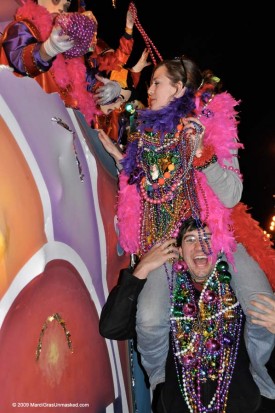Increasing your chances of reaping a worthy share of the coveted spoils begins with recognizing that, while throws are sometimes tossed at random to parade audiences, most of what float riders toss is aimed at specific people, with a lot of the best stuff saved for friends and family members along the way.
Getting rich quick in the Mardi Gras bead-and-bauble economy
Aggressively seeking loot at the 2009 Krewe of Endymion parade
Throws make Mardi Gras parades interactive, turning spectators into willful participants who revel in the thrill and challenge of acquiring prized beads and baubles.
Although throws are sometimes tossed at random to parade audiences, most of what comes off of parade floats is aimed at specific people, with a lot of the best stuff saved for friends and family members along the way. So how to increase your chances of reaping a worthy share of the coveted spoils?
Follow these tips:
As a float is passing, instead of just waiving and glancing quickly from rider to rider, zero in on a single rider. Establish eye contact, flash a big smile and make a lot of noise. If necessary, stretch the truth to help plead your case (example: “Please, mister — I came all the way from Manitoba! It’s my first Mardi Gras!”). Do not approach the float and try to grab throws from a rider.
Height is always an advantage, so consider bringing a ladder, footstool or ice chest to stand on. While ladders with seats bolted on top have long been are a great way to help kids overcome their height disadvantage, nowadays more and more adults seem to feel entitled to an elevated perch. And indeed, longer ladders without seats seem increasingly in vogue among grown-up throw mongers.
With all the jostling that goes on in the frenzy for throws, carrying another person on your shoulders can be dangerous, especially in the street. If you do it, stand next to a light standard or signpost in case you need to grab onto something to steady yourself.
When a throw lands on the street, don’t immediately reach for it. Instead, place your foot over it and wait a few seconds until it’s clear to those around that you’ve established ownership. Then pick it up. If you try to grab for it right away, your hand may get stomped on.
Sometimes, two or more people will snag the same throw. This is a give-and-take situation, and while it should go without saying that the first person to get his or her hand around a throw is the rightful owner, you’ll find some grabby people out there who wouldn’t know Carnival etiquette if it bonked them on the head. So, sometimes it’s best just to let something go rather than make a big issue out of it. Besides, there’s plenty for everyone.
Don’t send the wrong signal to riders by wearing a lot of beads. Instead, stash what you catch in a bag and consider auditioning for the role of the poor soul who has been deprived of bead wealth. When you catch the attention of a rider, point to your unadorned self while shouting, with a hint of desperation in your voice, “I need beads, mister — please!”
Choosing where to stand for a parade can be important. Being next to throw magnets is usually a profitable strategy. Throw magnets include cute kids, soldiers, fetching females, nuns, pregnant ladies, people in wheelchairs and anyone with a clever sign. Reap the overflow. And make sure you’re not standing under low-hanging tree branches (beads get caught in trees).
Also, note that some sections of parade routes are lined with barricades. As anyone afflicted with a lust for throws can attest, it can be almost unbearably frustrating when a barricade stands between you and a choice trinket lying just a few feet away in the street. Fortunately in the context of Mardi Gras, there is no shame in begging a police officer on the other side of the barricade to retreive the throw for you or at least kick it in your direction. Sometimes sweet talk can deliver the object of your affection.
While spectators right up against the barricades or in the first couple of rows won’t go home empty-handed, most dedicated booty-seekers prefer sections of the route that aren’t barricaded. For one thing, freedom of movement means more opportunities to forage for throws and interact with maskers. (Just don’t ever dart in front of a float or try to retrieve throws from underneath a float.)
When a parade comes to a standstill — a fairly frequent occurrence, especially with big parades — not being restricted by barricades can be particularly advantageous. People will crowd around the floats and fervently beseech the maskers, up close. If you think you’ve got some clever come-ons and one-liners, this is the time to give it your best shot.
The most famous — and sought after — parade throw is the Zulu coconut, also known as the Golden Nugget. Members of the Zulu Social Aid and Pleasure Club, unable to afford beads or trinkets, first began distributing coconuts in their natural hairy state in 1910. Shaving, painting and decorating evolved as techniques in the 1930s and 1940s. Still made by hand, they come in a variety of fanciful styles. Most parade-goers feel blessed to come home with just one of these cherished souvenirs. So imagine the elation and bragging rights if you were to snag 25.
A coconut collector who goes by the handle stephenj2 on YouTube accomplished this remarkable feat at the 2009 Zulu parade, and he’s got video footage of the spoils to prove it. His secret weapon: a pole with a hoop net on the end. It’s particularly effective given that Zulu coconuts, for liability reasons, must be handed, not thrown, to parade spectators.
A butterfly net is better than nothing, but if you’re really serious consider a fishing net with a telescoping handle that can extend at least six feet. Although pricey, the EGO Series 2 Telescoping Net from Cabela’s boasts a 56-inch slider handle that extends up to an “incredible” 87 inches. And with a hefty 31-inch netting depth — ideal trying to snag those elusive oversize plush toys and mascots — it might be just the ticket for aspiring big-time booty hunters.
Parade goers with the best signs often make out like bandits. Signs meant to challenge or incite riders can prove enticing (example: a bulls-eye target with the words “You Throw Like a Girl”). Clever topical riffs can also be effective. A sign spotted at the first Mardi Gras (2006) after Hurricane Katrina depicted water rushing through a ruptured floodwall and invited float riders to “Help Fill the Breach.” (Riders like to test their aim.) And an all-female krewe would likely reward a man holding a placard proclaiming, “I Always Put the Seat Down.”
Speaking of women’s krewes… If you’re begging for throws from lady maskers, drop the “mister.” Instead, say “Throw me something, dawlin!” or “Hey, dawlin’!” or “Throw me some love, dawlin’!”
Regrettably, some overzealous parade goers will push people, even children, out of the way to get throws, or brazenly interfere with a one-on-one “transaction” between a rider and a spectator. Yet the vast majority of the people lining the routes are considerate and don’t let the competition for throws trump civility. Make friends with the people around you, and be willing to share the wealth if you catch a cluster or bag of beads. Give throws to other people’s children. Chances are you will be rewarded — with throws, food, beverages, maybe even an invite to a party.
If you’re feeling particularly ambitious and a parade is rolling on the Uptown route, consider the “double-dip” strategy. Position yourself near the beginning of the route, and after the last float passes, walk a couple blocks to Magazine Street and catch the #11 bus downtown to the Central Business District or Canal Street, where you can watch the parade again and gorge on a second helping of trinkets.
However much it may seem that beads are an expression of status at Mardi Gras, like so much bling-bling on a rap star, don’t get so overloaded that you become a tangled mess and risk asphyxiation. And avoid sleeping with your beads on, or else you may need a pair of scissors in the morning to extricate yourself from a hopelessly intertwined mass of baubles.
MardiGrasTraditions.com


